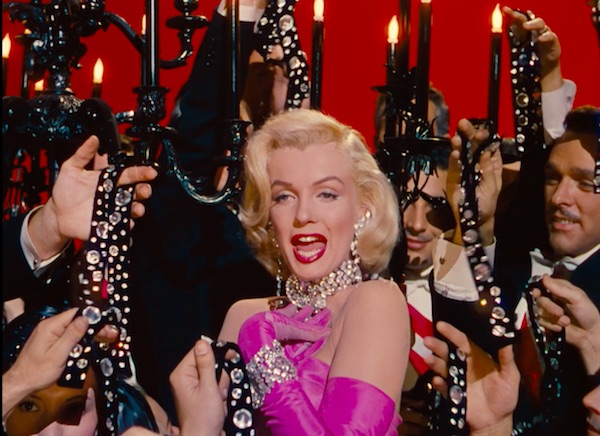Why are diamonds a girl’s best friend?

Gentlemen may prefer blondes, but blondes prefer diamonds for a number of reasons.
“The French are glad to die for love. They delight in fighting duels. But I prefer a man who lives and gives me expensive jewels. A kiss on the hand may be quite continental but diamonds are a girl’s best friend.”
Desperate men falling to their knees, a deep bloodshot hue of red permeating our vision, the glint of jewels adorning the neck, ears, wrists, and fingers of our heroine. And one cannot forget the pink dress of a shade that many have attempted to recreate but can never get quite right.
Simply put, Marilyn Monroe’s performance of the song Diamonds are a Girl’s Best Friend in her film Gentlemen Prefer Blondes is iconic. Filling the theatres upon its release and still homes to this day, the impression this movie left is felt. Still, not many understand the message Monroe was attempting to convey through her film and ultimately her unforgettable performance. Once looked at deeper, this famous phrase has a meaning that runs much deeper than jewels.
The film Gentlemen Prefer Blondes can be classified as a satirical comedy. This is attributed to its irony and most importantly the film’s protagonist, Lorelei Lee. Assumed to be ruled by her desire for material goods, the men in the film are highly suspicious of Lee’s motives. In rebuttal, she performs the film’s most celebrated number, Diamonds are a Girl’s Best Friend. Lee did this to show her male counterparts that she was aware of how she was perceived, although she didn’t completely believe what she was saying.
Still, she let the men in the audience and in the world know that they could easily be replaced by a diamond. Many, particularly advertisers, heard Monroe’s melody and used it to promote a harmful stereotype about women. Utilizing this phrase, they relied on the preconceived notion that women are driven by expensive items and that diamonds were no exception. Their methods also revealed a complex issue in our society, the lack of authentic love. In an attempt to make a diamond appeal to women, they claimed that, unlike their partner who would eventually lose their passion and go bland, a diamond would never crack, chip, or ever lose its shine. Marketers used this malevolent ploy in order to make a woman feel the need to compensate for the lack of true love in her life.
Like a diamond itself, however, this topic is multifaceted. This phrase can be interpreted as something that is in a way empowering, and in some respects it is. This phrase encourages women to look forward to more in life than the idea of love. Women have long been put in a situation where their life purpose is to “love” and marry, even if they aren’t satisfied with their matrimony. This encourages women to chase more than that. This interpretation is reminiscent of Louisa May Alcotts’ Joe March speech. March states: “Women, they have minds, and they have souls, as well as just hearts. And they’ve got ambition, and they’ve got talent, as well as just beauty. I’m so sick of people saying that love is just all a woman is fit for.”
In retrospect, diamonds are not a girl’s best friend because they’ll be more interesting than their partners, but rather because they represent the ambition and achievements women are capable of. From Marilyn Monroe’s retaliation to Joe March’s speech about the potential and possibility that lies in a woman, diamonds represent the material pleasures women indulge in while simultaneously showing that they can earn them themselves, without it being a gift from a man.
Sources Used:
- A History of Jewelry: A Jewelry Timeline » Blog »
- https://alldiamond.com/a/blog/why-diamonds-are-a-girl-s-best-friend?shpxid=1f351f97-e840-4540-8b39b997755d96aa#:~:text=There%20are%20many%20reasons%20why,a%20true%20expression%20of%20love.
- Why Diamonds Are a Girl’s Best Friend by Duncan Smith
- “Diamonds Are a Girl’s Best Friend” Is a Feminist Song at Frankly CuriousFranklyCurious
- Gentlemen Prefer Blondes is bubbly and smart, just like Marilyn Monroe
- Quote by Louisa May Alcott: “Women, they have minds, and they have souls, as…”

Hi! My name is Melissa Martinez and I am a sophomore at Armijo High School. I was born in Walnut Creek, CA but moved to Suisun City just before my second...